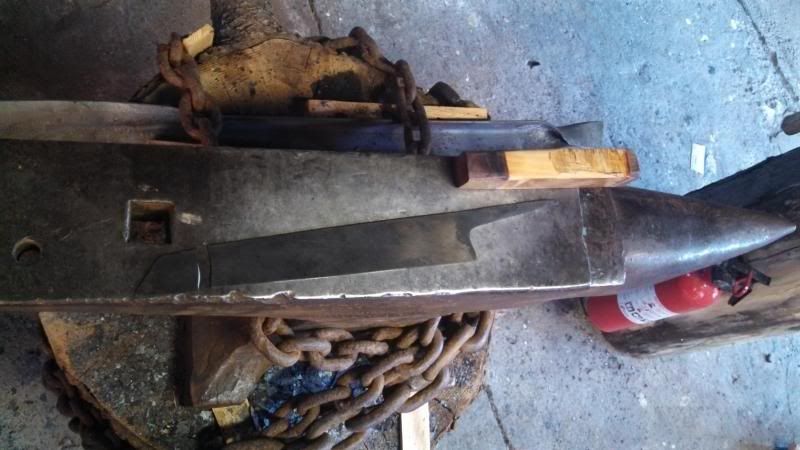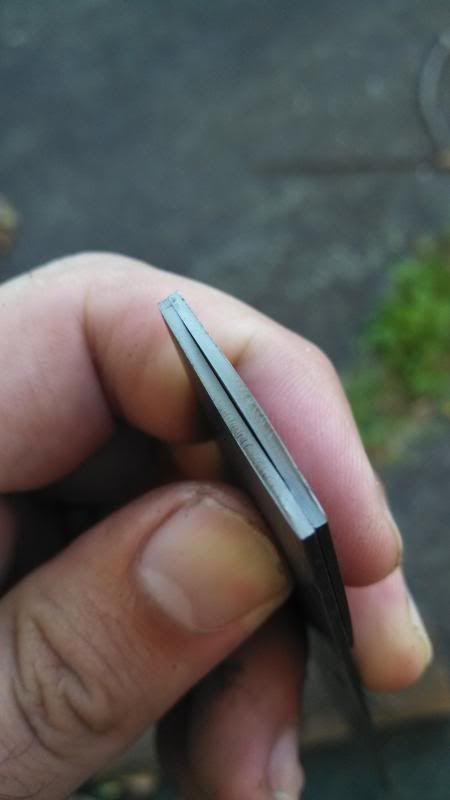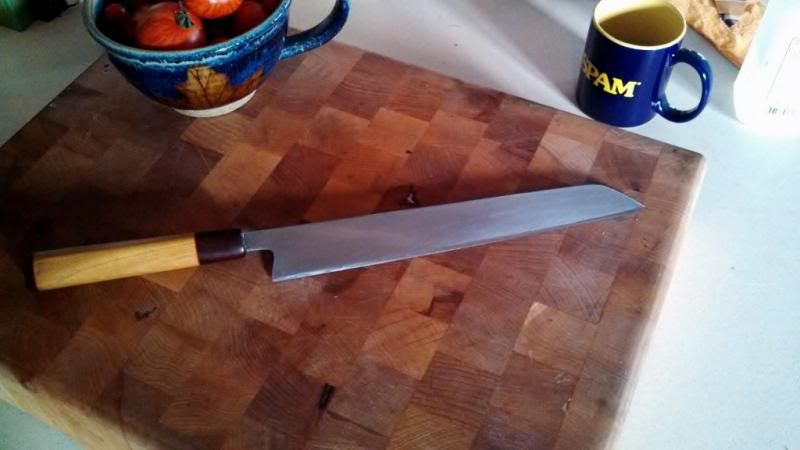|
|
|||||||
| Register | All Photos | FAQ | Members List | Calendar | ShopStream (Radio/TV) | Search | Today's Posts | Mark Forums Read |
| The Newbies Arena Are you new to knife making? Here is all the help you will need. |
 |
|
|
Thread Tools | Display Modes |
|
#1
|
||||
|
||||
|
Some heartache and call for critique....
 gutted. Put a lot of time in this thing and got a little careless with straightening out of temper. Also Hi! I don't post much because...well...one of these days I might have something useful to contribute.  This was going to be a sujuhiki, 9 1/4 in blade, 1.9 mm spine over heel tapered down to .9mm before final grind So I'm stubborn and have only worked with hyper-eutectoid steels...I don't do this for the sight of a finished polished blade just yet..more of just seeing what I can get away with otherwise I'd be quenching in a bucket full of tears shed for cracked 1095 blades. I swore off 1095 forever and o-1 until I get a proper oven to try cruforge. Folks a AKS recommended their 1080+ saying it was, at the very least, comparable to 1095 with the benefits of waaay less temperamental HT. Long story short this stuff was bendy out of tempering, waaay more bendy than I'm used too (probably ehy I ended up pushing it too far) is this normal? I realize thisquestion is grossly lacking in quantifiers but I've only every finished my san-mai blades before and this stuff bounced back from about every straightening method I threw at it. .......there might be a proper question in that mess...its late... I will ask for a critique, sending the broken piece put for testing but I was hoping to get a grain critique from some veterans. I think it turned out really quite good but I haven't cross sectioned any steel quite like this yet and will be will into the final stages of MKii before I get the results back.  Cheers! Last edited by Midwinter; 08-24-2013 at 01:24 PM. Reason: Fixed photos |
|
#2
|
|||
|
|||
|
What was your HT process and oil?
|
|
#3
|
||||
|
||||
|
Pics fixed.
I have a fairly basic setup. Triple normalize, ash anneal, veterinary grade mineral oil @ 120f for quench tempered at 335f, three cycles of three hours to compensate for the mass of the straightening jig it was clamped into. Figured the mineral oil would be fast enough with the added chromium and vanadium in the steel. |
|
#4
|
||||
|
||||
|
I've never used 1080+ but I have used a good bit of 1095 and I've made a couple of 11" Sujihikis with it so my comments might have some basis in fact. First is, I doubt 335F is hot enough to allow the blade to straighten much. I also use that 'clamped in a jig' method of straightening during tempering but it's my understanding that the steel won't really notice anything less than about 400 degrees.
Second, you said you normalize and then anneal and that seems backwards to me. I also ash anneal when the steel starts out being curved or maybe just not as fully annealed as it should be. Once annealed, I straighten the soft steel cold. Then, during the HT I raise the steel to normalizing temp and then check to see if it warped again (often does). If so, I straighten it again while there is still color in the steel and then allow it to cool to black before putting back into the oven. Usually, three normalizing cycles like this are enough for the blade to stop warping. Next, I quench the steel in warm oil and most of the time the blade comes out straight or with very little warp. If there is warp, I then do as you did with the jig and long temper times but I use a higher temp (about 425F). BTW, my jig is built so that it can put a LOT of pressure on a blade - enough to break it if applied cold. So, I torque it down pretty firmly for the first temper cycle, then more for the second cycle while the blade is hot, then still more for the third - never broke one this way. Maybe something in there will help with your situation ... Last edited by Ray Rogers; 08-24-2013 at 02:28 PM. |
|
#5
|
|||
|
|||
|
Ya, what Ray said. I have worked with 1084 which is near to what you have and I do one heating cycle before I clamp if it's needed. Tempering at 335? is only going to relieve stress in the blade but still leave it brittle. I've done well with the 1084 at 400? but I might try 425? if I was dealing with a large chopping blade.
BTW, the grain on the broken blade looks fine. Doug __________________ If you're not making mistakes then you're not trying hard enough |
|
#6
|
||||
|
||||
|
Quote:
1080+ reminds me of 5160 but eutectic... pretty good steel I suspect:http://www.alphaknifesupply.com/zdat...eelC-1080+.htm To remove warp without the risk of a broken blade: after the first tempering cycle, clamp the blade to a flat steel surface, shim it to assure the blade is straight... temper the blade clamped to the flat steel, and give it a good 2 hour temper... remove from the oven while still hot, wearing gloves unclamp the blade and check straightness, hand tweek as needed... quench the blade in water to cool. The blade should now be straight, if it is not do it again. I had one blade that was 1095 with a wrought iron core that needed a lot of straightening, but 3 tempering cycles clamped flat to a steel bar fixed it. __________________ A good friend told me one time about forging "What is there not to like, you get to break all the rules you were told as a kid, don't play with that it is sharp, don't play with fire, and don't beat on that" Wade Holloway See some of my work. |
|
#7
|
||||
|
||||
|
Thank for the responses everyone!
So...yah I totally screwed up the normalize and annealing order. I'd like to pretend I'm better than that but it turns out I'm not. As far as the break itself, as I said, I deserved it. The blade slipped from my hand and hit the edge of a vise. The point of the initial post was to ask what the average "bendines" of ~1080 steels would be since I haven't worked with anything similar as of yet. Confession: Tempering at 335f was being greedy. I was chasing numbers and was afraid of anything under hrc 60 HOWEVER; Is 400f specific to austenite/martensite malleability or is it specific to a carbon%? Can alloying elements affect this? Is this a rule of thumb? In the interest of full disclosure my gas forge and I are still getting to know each other. I lack a pyrometer, PID, Kiln or anything contributing to accuracy at this time so I guess I'm more interested in the boundaries of what ruins a blade before I dare even give one away as a gift presuming it is a functional tool. I did my (chef's) apprenticeship at a traditional sushi bar back home in Seattle. It was a good few months before anything I touched was out in front of a customer so the whole "narrowing the boundaries of unacceptable vs. acceptable" may havebecome my default learning method  Thanks everyone, Y'all rock. |
|
#8
|
||||
|
||||
|
I'm sure there is something scientific to say about 400F but basically I do that or more because every formula I have seen from the manufacturers or other reputable source never go below that if they intend to achieve the combination of hardness/toughness that we want to see in a good blade. As for chasing numbers, remember that each steel that we use for blades has two important numbers. One is the maximum hardness that is possible for that steel - this we try to achieve when we quench. The other is the proper working hardness - the hardness at which the steel has the best combo of desirable characteristics for a knife blade and this we achieve with the temper. Rc 60 is generally too hard for a 1080 blade, too likely to chip or break more easily than it should at that hardness. Rc 58 would be about right for edge holding and suitable toughness for a 1080 blade (depending on the intended use of the blade) . For instance, your sushi knives could get away with being Rc 60 because even though the edge is thin if used properly the edge will never touch anything hard enough to chip it. Problem is, of course, we don't live in that perfect world ...
|
|
#9
|
|||
|
|||
|
If you are trying to austinize your steel prior to hardening you can use a magnet to spot when it becomes non-magnetic and then get the steel a little hotter (brighter) and hold for a couple of minutes. An alloy like the 1080, 1084, 1075, or even 5160 are more forgiving when it comes to heat treating like this. Another thing is to spot decalesence and recalesence in the steel as it heats and cools.
These effects are caused by glow in the steel being dulled as the crystals change phase to austinite and then back to ferrite. It is best describes as a shadow passing across the blade. I learned to spot it first by watching the steel cool (recalesence) and then I was able to spot it as the steel heated up and austinized (decalesence). As far as tempering goes I would recommend that you put a thermometer right by the blades inside the oven. If your wife nixes the use of the kitchen oven then you will have to go out and buy a toaster oven that you can call your own. I don't recommend that you use a torch to temper with because 1) it's hard to guage temperature from the patina that forms as you heat the steel and 2) it doesn't expose the steel to the heat long enough. As far as the effect of the carbon content on tempering goes, yes the more carbon the higher the tempering temperature needs to be because there is more carbon to move to relieve a higher stress within the martinsite matrix. However, when you start talking about the more complex alloys that knifesmiths are less likely to use the other alloying elements come into play too and some of the rules that we work simpler steels by no longer apply. Doug __________________ If you're not making mistakes then you're not trying hard enough |
|
#10
|
|||
|
|||
|
Wow...thank you for the thread Midwinter. I had to read it a few times to wrap my head around the posts (I'm still having my first coffee of the day, so it's a bit of a stretch). I appreciate the pics as I don't often see what grain structure looks like. Sorry about your blade. I am only working on my third knife by hand files so I'd be pretty disappointed to break a blade as it takes so long.
|
|
#11
|
||||
|
||||
|
Vindication!
Glad someone found all this useful. I swear I was as sick of reading the same advice to noobs as I'm sure the veterans are of typing it all out.
switched my temper to an accurate 410f, was gifted 30 gallons of various quench oil ( lucky me! ) and turned out this...  1080+, cocobolo and osage handle with red spacers, lab results say averages of hrc 59.7, 59.4 and 59.2 ant the tip, center and heel respectively. Still some hotspots in the forge, I have a 2 venturi burner setup with open ends so I plugged on end and made a stainless steel baffle to even things out. 17" overall heel to tip is 10 3/4" .....will never do anything this long again....ever. Anyway thanks again for all the help everyone! .live your dream haha. |
|
#12
|
|||
|
|||
|
Good work on that knife.
Doug __________________ If you're not making mistakes then you're not trying hard enough |
 |
| Tags |
| 1084, 1095, 5160, back, blade, blades, cold, edge, fixed, flat, forge, hand, hot, iron, jig, knife, knives, made, o-1, post, stainless steel, steel, surface, temper |
| Currently Active Users Viewing This Thread: 1 (0 members and 1 guests) | |
| Thread Tools | |
| Display Modes | |
|
|
 Similar Threads
Similar Threads
|
||||
| Thread | Thread Starter | Forum | Replies | Last Post |
| Help with a critique please | Wade Holloway | Knife Making Discussions | 5 | 04-07-2009 09:42 AM |
| A few new ones - critique welcome | SharpByCoop | Knife Photography Discussion | 6 | 04-02-2008 05:37 AM |
| critique please | muzzleup | Knife Photography Discussion | 7 | 03-19-2006 03:54 PM |
| Please critique!! | SCW | The Sheath/Holster Makers Forum | 6 | 01-12-2004 11:42 AM |
| Could someone critique this please | Colin KC | The Sheath/Holster Makers Forum | 16 | 11-30-2003 10:02 AM |